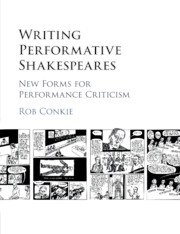1 - Materialising Shakespeare
Published online by Cambridge University Press: 05 March 2016
Summary
Writing performative Shakespeares means writing material Shakespeares. Barbara Hodgdon, perhaps the original Shakespeare in performance material girl, describes The Taming of the Shrew, on the very first page of The Shakespeare Trade, as ‘highly overinvested real estate, a property without boundary marks that attracts discussion about material histories, material texts, and theatrical as well as cinematic reproductions’. Moreover, these performative reproductions are ‘where the play, re-textualized and re-textured by the actors’ bodies and voices, appears in its most material form’. The last chapter of The Shakespeare Trade catalogues the stuff Stratford-upon-Avon is made on – Shakespearerelated trinkets, monuments, souvenirs and relics – and the chapters in between deal with matter and matters such as: make-up (43); costumes (45); bodies (46); scrims (48); theatre programmes (83); production photographs (84); state documents (119); portraits (160); reviews (172); and mud (176). Carol Chillington Rutter, similarly willed towards materiality and performativity, is Hodgdon's heir (or one of them). Where Hodgdon considers ‘a wedding dress that mattered’, that worn by Alexandra Gilbreath in Gregory Doran's 2003 RSC Shrew, a dress she later re-viewed on an archive mannequin, Rutter, collaborating with Tom Cornford, writes about a practice-led research project to unpin and undress Desdemona (Hodgdon is also interested in undergarments, particularly an ‘absent farthingale’). Hodgdon writes that ‘When a costume performs, it becomes material for interpretation’: Rutter echoes, via Cornford, ‘that a play operates as an archive of its own world, that it offers materials for its own interpretation.’ In Enter the Body, which like The Shakespeare Trade, has major chapters on both Othello and Antony and Cleopatra, Rutter is interested in, of course, bodies: the materiality of corpses (2), cadavers (9), decapitated heads (13), and the circumscriptions other materials perform on bodies corseted (22), wheelchair- bound (26) or blacked up (59). She focuses, too, on what these (actors’) bodies wear, and on the on-stage materials with which they interact (chapter 4, but especially 104–110, 115–120, 140–141).
Inspired by these studies and scholars, and by others like them, this chapter poses three overarching questions (and a series of subsidiary questions) in order to explore the material dimension of performative Shakespeares. The overarching questions are: one, how does performance and production materialise through the processes and practices of rehearsal? Two, how is rehearsal (and, to a lesser extent, production) materially constituted?
- Type
- Chapter
- Information
- Writing Performative ShakespearesNew Forms for Performance Criticism, pp. 25 - 48Publisher: Cambridge University PressPrint publication year: 2016

